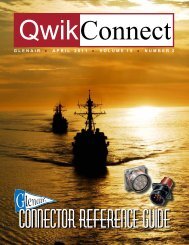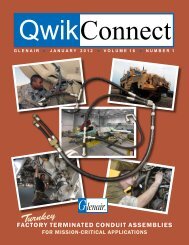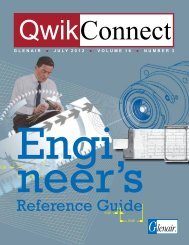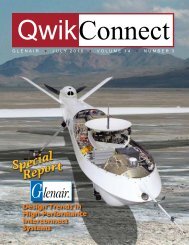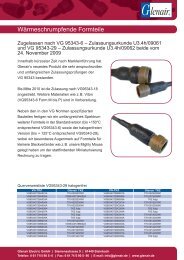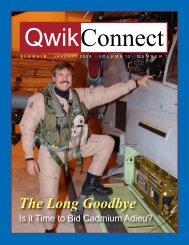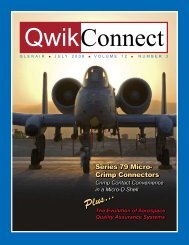April 2010 - Glenair, Inc.
April 2010 - Glenair, Inc.
April 2010 - Glenair, Inc.
You also want an ePaper? Increase the reach of your titles
YUMPU automatically turns print PDFs into web optimized ePapers that Google loves.
cost of repainting the freeboard of an aircraft carrier<br />
is about $20M. The buildup of paint used to cover<br />
running rust accumulates to the extent that it results<br />
in a substantial weight penalty which detracts from<br />
the ship’s hydrodynamic performance.<br />
The second significant issue with running rust<br />
from carbon steel topside components is that they<br />
must be periodically replaced. While this sounds<br />
simple, the logistics of shipboard maintenance is not.<br />
A ship is a floating city that must make all of its own<br />
power, cook all of its own food, and dispose or store<br />
all of wastes. It must also carry all of the things that<br />
are necessary to operate the ship and feed the crew.<br />
There is not a lot of room for storage of repair parts.<br />
When it is determined that a topside component has<br />
corroded to the point that it needs to be replaced, it<br />
is not likely that a replacement component is readily<br />
available or even on board. Consequently, the<br />
problem is documented on a work request (4790/2K)<br />
and entered in the Current Ship’s Maintenance Plan<br />
(CSMP) 6 .<br />
At the ship’s next maintenance availability, which<br />
could be up to six months after the original problem<br />
was noted, the ship’s maintenance manager will<br />
screen the work, normally to ship’s force. By the time<br />
a Sailor has the time and the proximity to logistics<br />
resources to work on the problem, the simple running<br />
rust fastener has degraded to the point that the<br />
entire bracket requires replacement. In the worst<br />
case scenario, the corrosion may have progressed<br />
to the point that structural damage has occurred.<br />
At this point, the original work request is rewritten,<br />
the scope expanded and reentered into the CSMP.<br />
The ship’s maintenance manager then must screen<br />
the structural repair work to a depot level activity.<br />
Ultimately, the cost of the fifty cent carbon steel<br />
fastener has resulted in a twenty thousand dollar<br />
repair job.<br />
Another issue with the use of corrosion resistant<br />
topside materials is that they are generally cathodic<br />
with regard to the surrounding carbon steel structure.<br />
All metals are ranked in a galvanic series according<br />
to their relative affinity of their electrons. A metal that<br />
is more anodic than another will supply electrons<br />
to the more noble cathodic metal, corroding in the<br />
process. What results with the application of noble<br />
metal alloys in the Fleet is that there is a galvanic<br />
reaction with the surrounding materials which leads<br />
QwikConnect<br />
to severe pockets of localized corrosion. This is<br />
especially the case with topside enclosures that<br />
have noble metal components. Recent topside<br />
applications of titanium metal alloys on surface<br />
ships have shown that active corrosion products are<br />
still evident inside electrical enclosures. The only<br />
DDG■Class■Composite■<br />
Fairwater<br />
currently available solution to rectify this problem is<br />
to require the installation of desiccant packets inside<br />
the enclosure to absorb all moisture so that there<br />
is no electrolytic coupling for the flow of electrons<br />
that is the essence of the electrochemical reaction.<br />
This of course requires that the desiccant bags be<br />
6 QwikConnect n <strong>April</strong> <strong>2010</strong>



